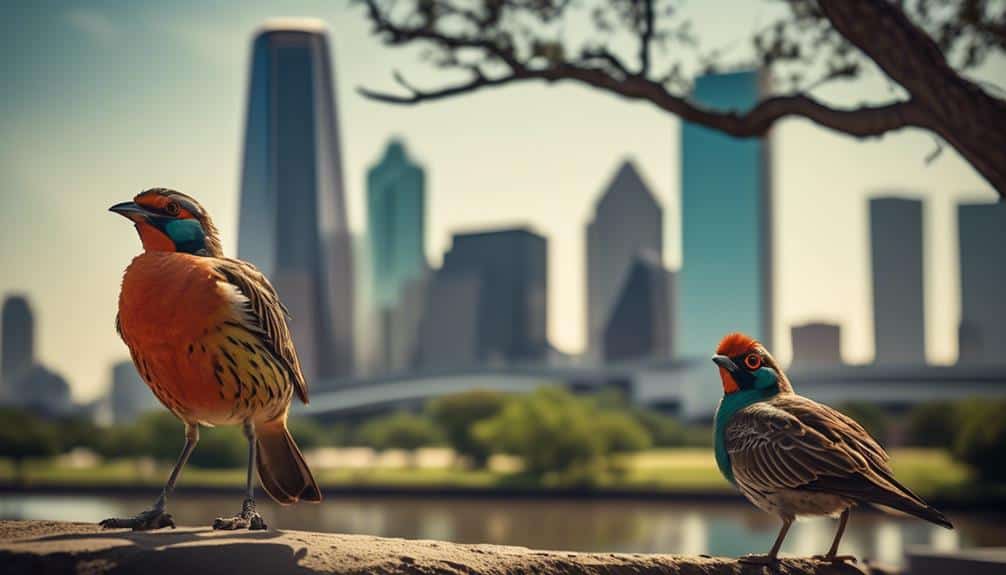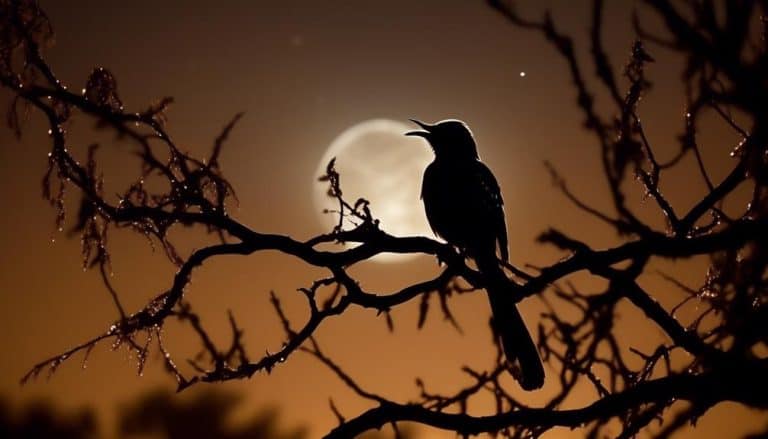As I was strolling through a park in Dallas, Texas, I couldn't help but notice the vibrant colors and melodic songs of the birds surrounding me. It was as if they knew I was seeking knowledge about the common avian residents of this city.
Let me tell you, Dallas is home to a diverse array of bird species, each with its own unique characteristics and charm. From the elegant Northern Cardinal to the majestic Red-tailed Hawk, there is so much to discover about the common birds in Dallas, and I invite you to join me on this journey of exploration.
Northern Cardinal
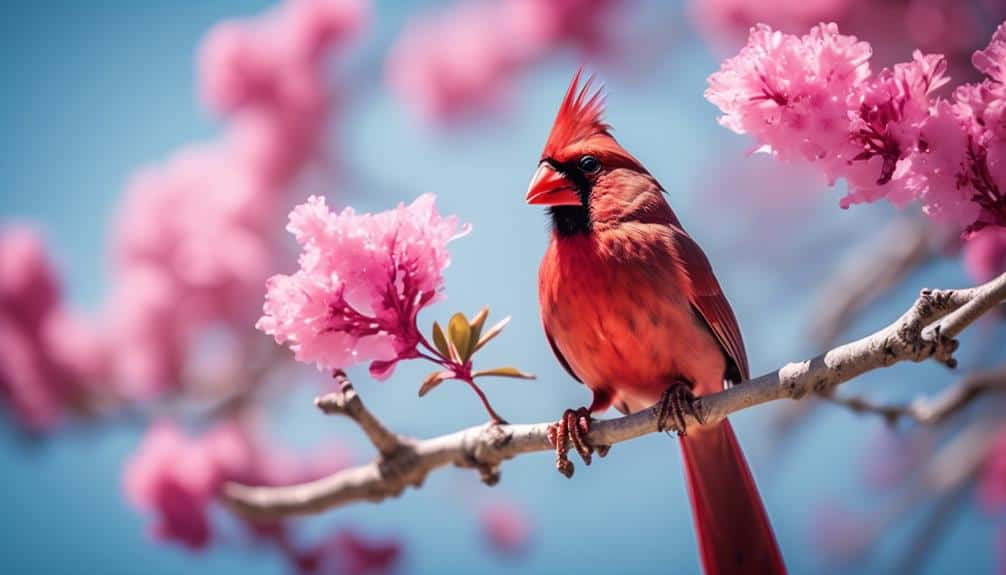
The Northern Cardinal, scientifically known as Cardinalis cardinalis, is a common bird species found in Dallas, Texas. This species is known for its vibrant red plumage, which holds significant importance in their mating rituals.
The habitat preferences and nesting habits of the Northern Cardinal contribute to their successful breeding and survival.
Northern Cardinals are primarily found in dense vegetation such as shrubs, thickets, and woodlands. They prefer areas with ample food sources, including seeds, fruits, and insects. These birds are known to establish territories and defend them fiercely, especially during the breeding season. They construct their nests in shrubs or low trees, using twigs, grass, and leaves. The female Northern Cardinal is responsible for building the nest and incubating the eggs, while the male provides food and protects the territory.
The bright red plumage of the male Northern Cardinal plays a crucial role in attracting a mate. During courtship, the male Cardinal displays his vibrant feathers to the female, signaling his strength and genetic fitness. The female is more likely to choose a mate with brighter plumage, indicating good health and strong genetics. This elaborate display of red feathers is a visual cue that enhances the male's chances of successful reproduction.
American Robin
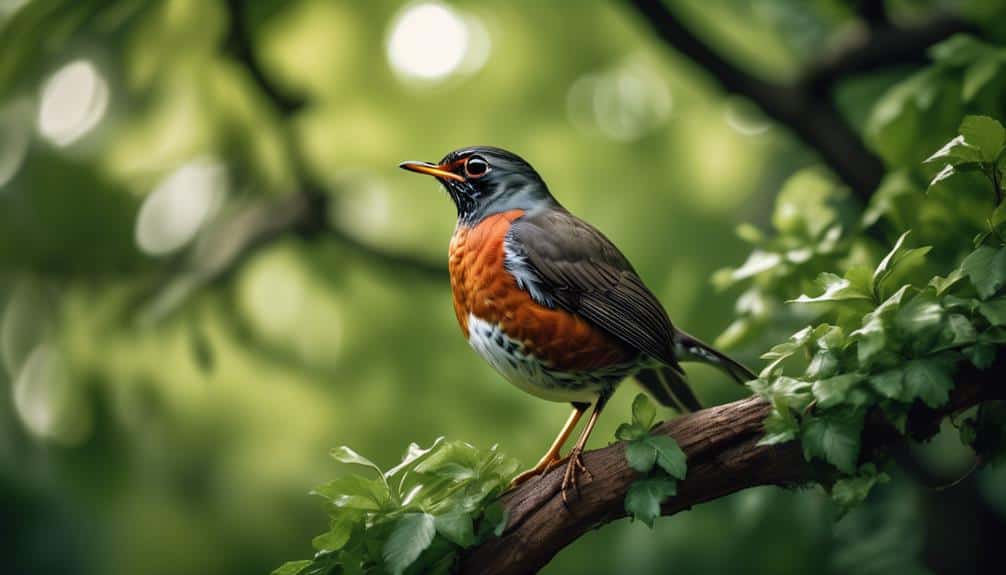
In Dallas, Texas, the American Robin, scientifically known as Turdus migratorius, is a commonly observed bird species. The American Robin is a medium-sized thrush with a distinctive appearance. It has a grayish-brown back, a reddish-orange breast, and a white belly. The American Robin is known for its melodic song, which can often be heard in the early morning hours.
Habitat preferences play an important role in the distribution of American Robins. They're typically found in open woodlands, parks, and suburban areas with ample trees and shrubs. They prefer areas with a mix of open spaces and vegetation, as this provides them with a diverse range of food sources.
Migratory patterns are another interesting aspect of the American Robin's behavior. Although they can be found year-round in some parts of Texas, many American Robins migrate to the northern United States and Canada during the breeding season. In the spring, they embark on long-distance flights to their breeding grounds, where they build nests and raise their young. In the fall, they return to warmer regions, such as Texas, to spend the winter months.
Mourning Dove

Observing the Mourning Dove, scientifically known as Zenaida macroura, provides insights into its unique characteristics and behaviors. This medium-sized bird is easily recognized by its soft, mournful cooing sound and slender body. The mourning dove is a common sight in Dallas, Texas, and can be found in various habitats, including woodlands, parks, and residential areas.
One fascinating aspect of the mourning dove is its breeding habits and nesting behavior. They typically breed from spring to early fall, with males performing elaborate courtship displays to attract females. The female dove constructs a flimsy nest made of twigs, grass, and leaves, usually in trees or shrubs. It's interesting to note that mourning doves often reuse their nests, adding new materials each year.
Another important role of mourning doves is their impact on local ecosystems through seed dispersal. Mourning doves primarily feed on seeds, which they swallow whole. They've a unique adaptation in their digestive system that allows them to quickly digest the seeds and excrete them intact. This process aids in seed dispersal, helping to regenerate plant species and maintain biodiversity in their habitat.
Red-tailed Hawk
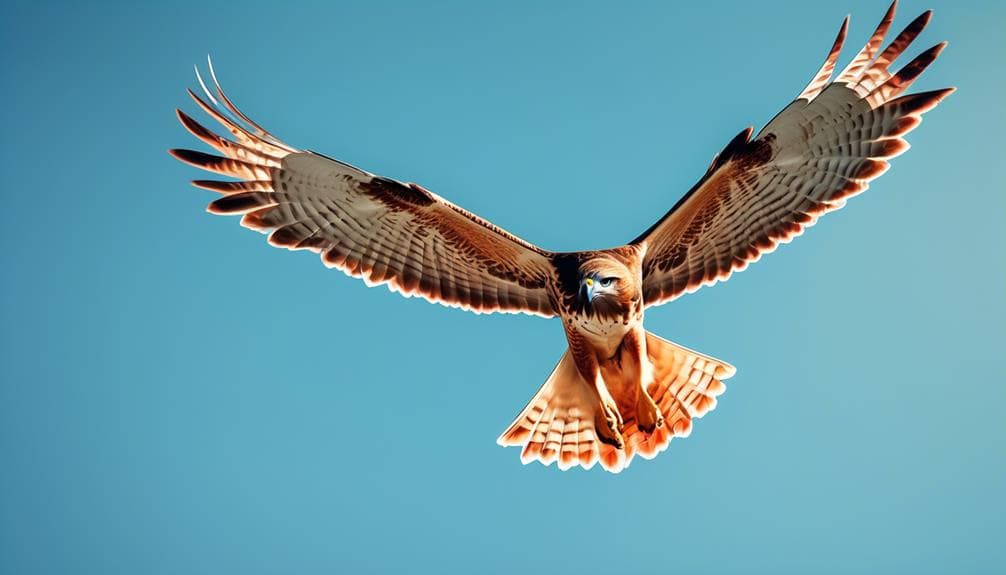
With its distinctive red tail and impressive wingspan, the Red-tailed Hawk, scientifically known as Buteo jamaicensis, is a formidable bird of prey commonly found in Dallas, Texas. Known for its hunting prowess, the Red-tailed Hawk is an expert at locating and capturing its prey. It primarily hunts small mammals such as mice, rabbits, and squirrels, using its keen eyesight to spot its targets from great distances. Once a suitable prey is spotted, the hawk dives down at incredible speeds, using its sharp talons to seize and immobilize its victim. It then carries its prey to a nearby perch or nest to consume.
In addition to its hunting habits, the Red-tailed Hawk is known for its impressive migration patterns. Like many other bird species, these hawks undertake long-distance journeys to find suitable breeding and feeding grounds. They're known to migrate both in spring and fall, with some individuals traveling thousands of miles. During migration, they take advantage of rising thermal air currents, using them to soar effortlessly across vast distances. These migrations often span across several states and even countries, showcasing the Red-tailed Hawk's remarkable ability to navigate and adapt to changing environments.
Great Blue Heron

As I continued my exploration of the avian inhabitants of Dallas, Texas, my attention shifted from the impressive Red-tailed Hawk to the elegant presence of the Great Blue Heron.
The Great Blue Heron (Ardea herodias) is a majestic wading bird that can be found in various habitats across Dallas. These birds are commonly found near bodies of water, such as lakes, marshes, and rivers, where they can easily find their main source of food – fish.
Great Blue Herons are skilled hunters with a feeding behavior that's both fascinating and efficient. They patiently stand motionless at the water's edge, waiting for their prey to approach. With lightning-fast reflexes, they strike at fish, frogs, and even small mammals, using their sharp beaks to spear their catch. Their long legs allow them to wade in shallow water, giving them an advantage when it comes to hunting.
Conservation efforts for Great Blue Herons in Dallas are crucial to protect their habitats and ensure their survival. These birds face threats such as habitat loss due to urbanization and pollution of water sources. Organizations like the Audubon Society and local wildlife agencies work together to preserve wetland areas and create protected spaces for these herons to nest and feed.
Additionally, educating the public about the importance of these birds and their habitats can help raise awareness and encourage conservation efforts.
Carolina Chickadee

The Carolina Chickadee (Poecile carolinensis) is a small, energetic songbird commonly found in the woodlands and suburban areas of Dallas, Texas. This species is known for its distinctive black cap and bib, white cheeks, and grayish-brown back and wings. With a length of about 4.5 inches and a wingspan of 7.5 inches, the Carolina Chickadee is a compact and agile bird.
| Carolina Chickadee | |
|---|---|
| Scientific Name | Poecile carolinensis |
| Average Length | 4.5 inches |
| Average Wingspan | 7.5 inches |
| Habitat | Woodlands, suburban areas |
| Behavior | Active, social, forages for insects and seeds |
| Vocalizations | Whistled calls, chick-a-dee-dee-dee |
Habitat and Behavior:
Carolina Chickadees are commonly found in woodlands and suburban areas with a mix of trees and shrubs. They prefer habitats with a dense understory and are often seen foraging for insects and seeds in these areas. These birds are highly active and social, often seen in small groups or mixed flocks with other songbirds. They are known for their acrobatic foraging behavior, hanging upside down on branches to reach insects.
Vocalizations and Communication:
Carolina Chickadees are known for their distinctive vocalizations. Their calls are often described as a whistled "fee-bee" or "fee-bee-fee." They also have a signature vocalization, the "chick-a-dee-dee-dee" call, which is used for communication within their social groups. These vocalizations serve as contact calls to keep the group together and alert others of potential threats. Carolina Chickadees also use soft, high-pitched calls during courtship and nesting season.
Frequently Asked Questions
How Do Northern Cardinals Attract Mates and Establish Their Territories?
Northern cardinals attract mates by singing elaborate songs and displaying vibrant plumage. To establish their territories, they engage in aggressive behaviors such as chasing away intruders and marking boundaries with vocalizations and physical displays.
What Is the Lifespan of an American Robin and How Many Broods Do They Typically Have in a Year?
The American robin's lifespan is typically around 2-6 years, but some have been known to live up to 14 years. They typically have 1-3 broods in a year, with each brood consisting of 3-4 eggs.
What Is the Unique Characteristic of the Call of a Mourning Dove and How Does It Contribute to Their Courtship Behavior?
The unique characteristic of a mourning dove's call is its mournful, soft cooing sound. Research on mourning dove vocalization studies has shown that these calls play an important role in their courtship behavior and mating rituals.
How Does the Red-Tailed Hawk's Hunting Behavior Differ From Other Bird Species in Dallas?
The red-tailed hawk's hunting behavior differs from other bird species in Dallas due to its feeding habits and nesting behavior. It is a skilled predator, using its sharp eyesight and powerful talons to catch prey.
What Are the Main Threats to the Population of Great Blue Herons in Dallas and What Conservation Efforts Are Being Taken to Protect Them?
The main threats to the population of great blue herons in Dallas include habitat loss, pollution, and disturbance from human activities. Conservation efforts focus on preserving wetland habitats, implementing pollution controls, and raising awareness about the importance of protecting these majestic birds.
Conclusion
In conclusion, the Dallas, Texas area is teeming with an astonishing variety of avian life. From the vibrant plumage of the Northern Cardinal to the elegant flight of the Great Blue Heron, these common birds captivate the senses with their beauty and grace.
The skies are alive with the majestic Red-tailed Hawk, while the melodious songs of the American Robin and Carolina Chickadee fill the air.
Truly, Dallas is a birdwatcher's paradise, offering a captivating glimpse into the natural world.

